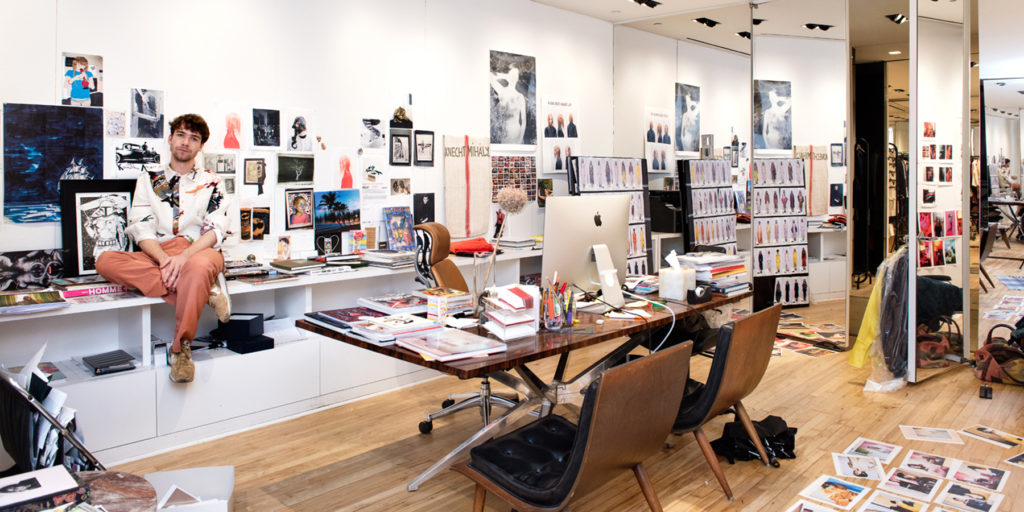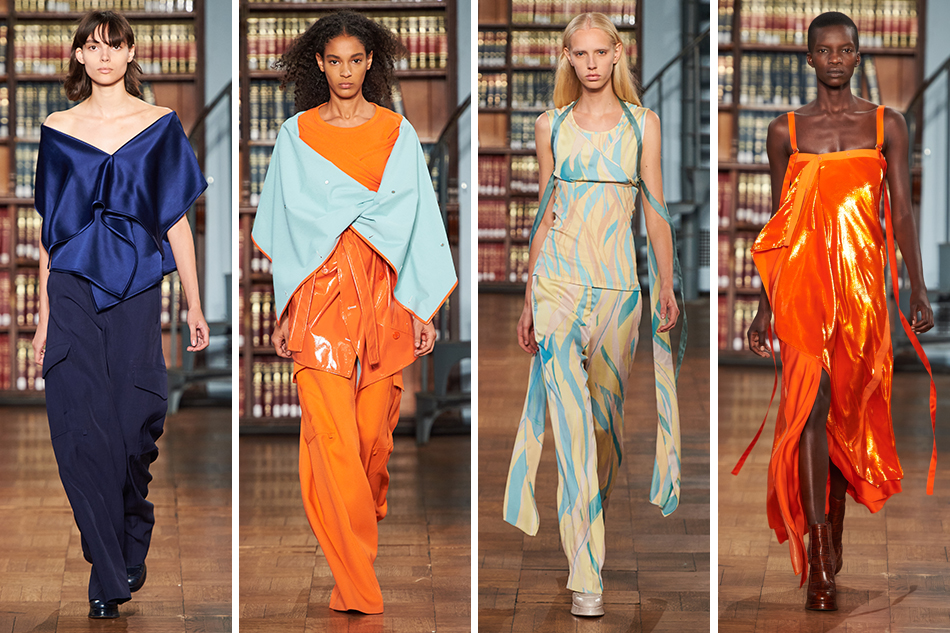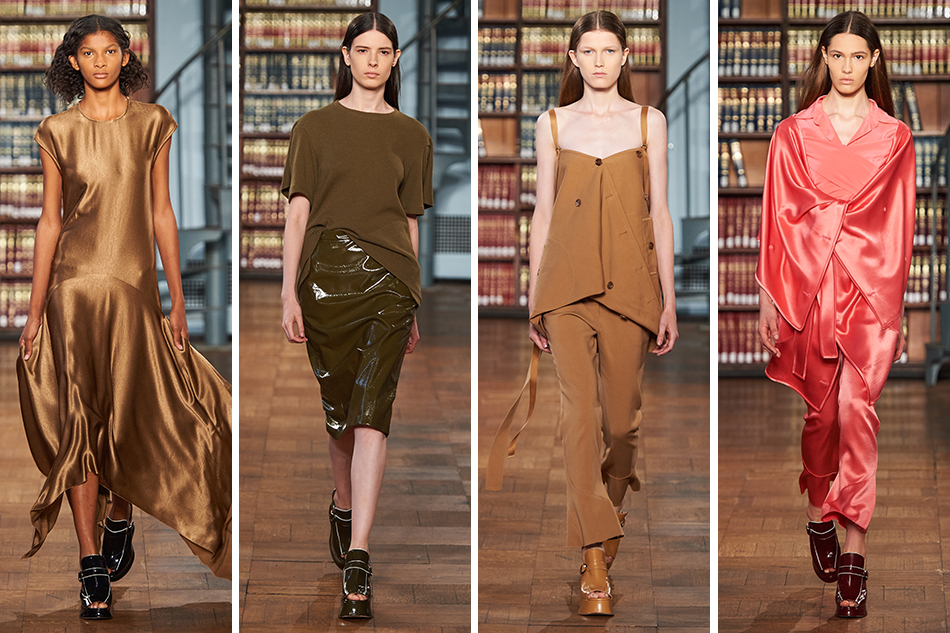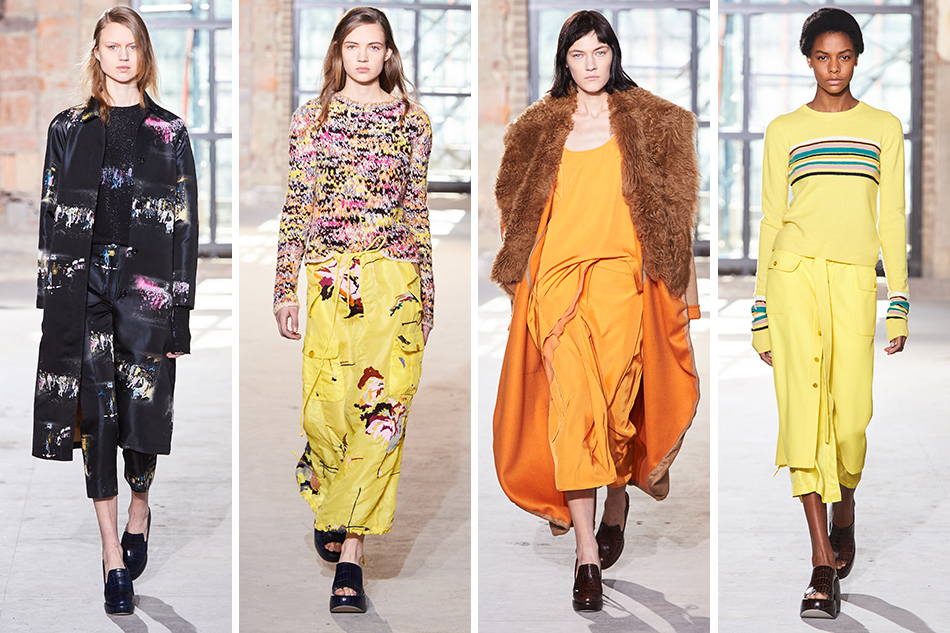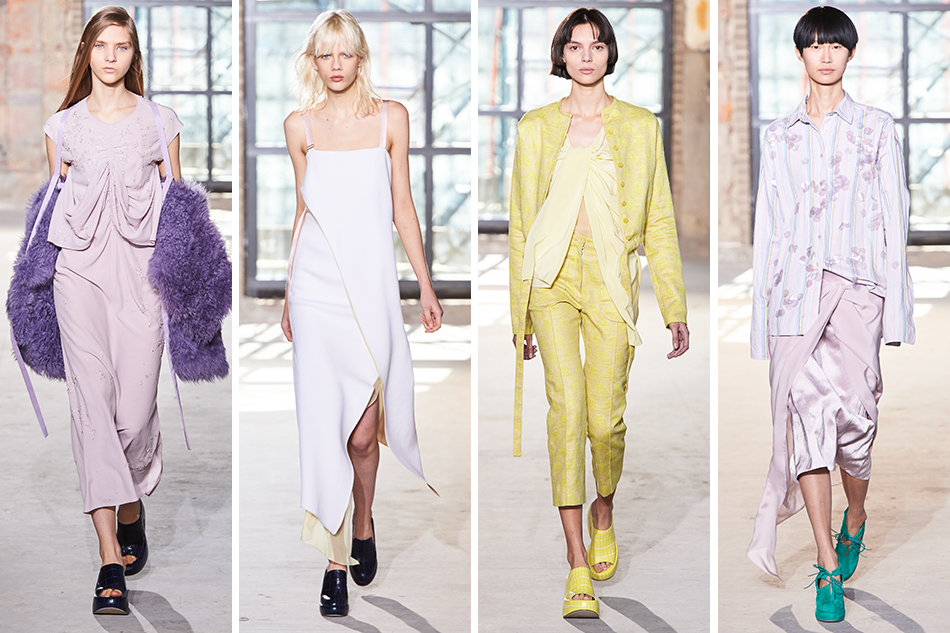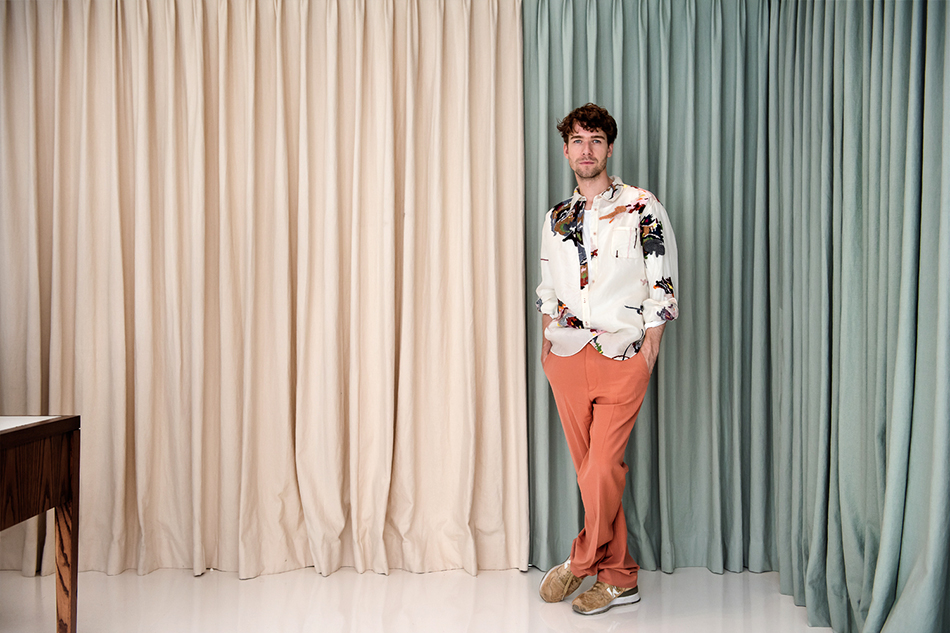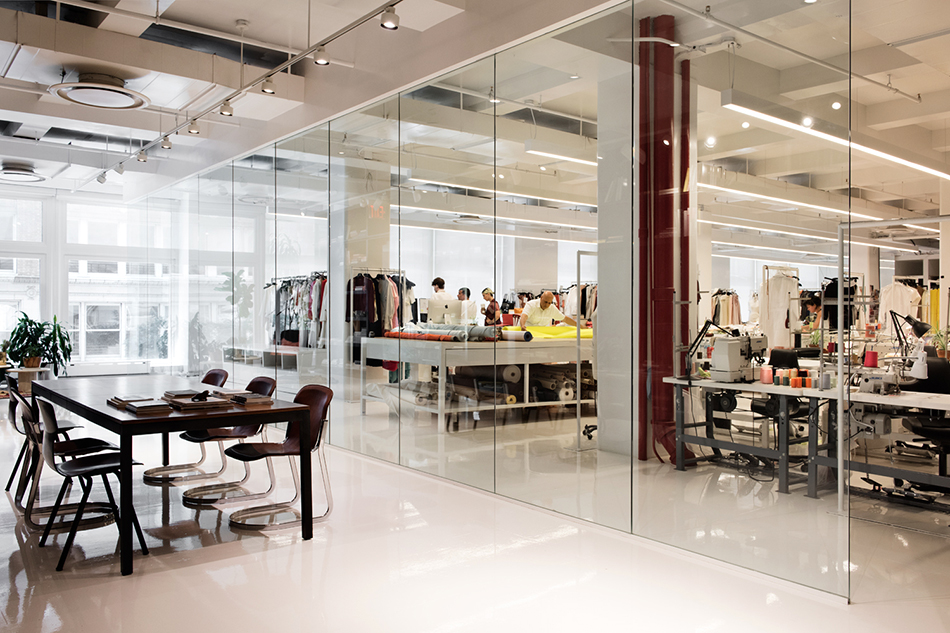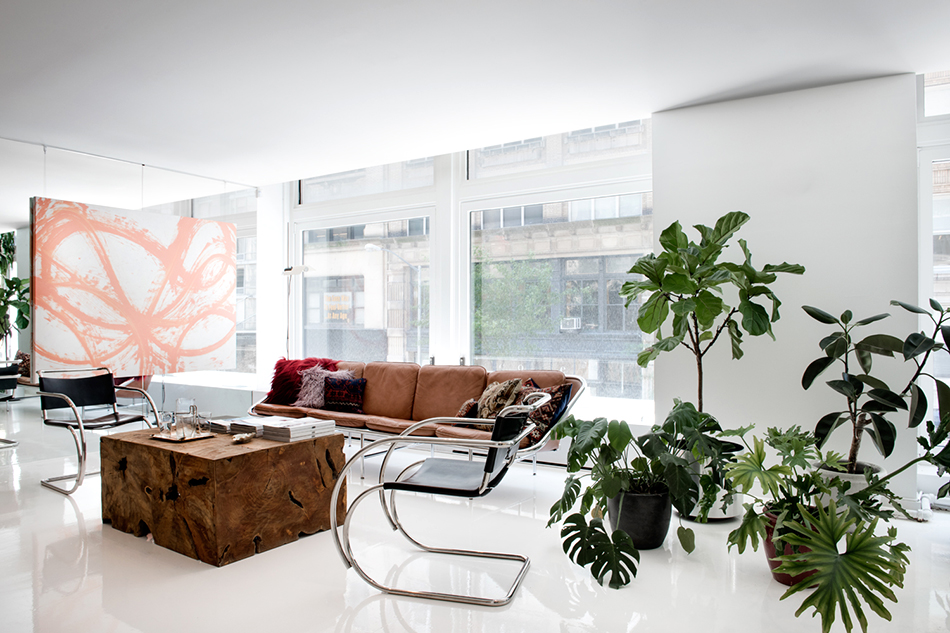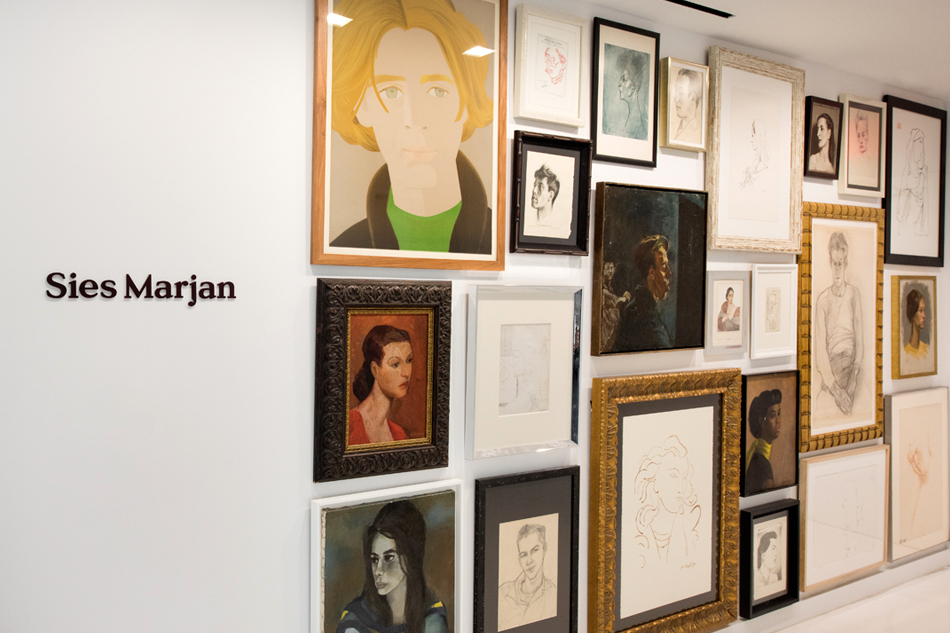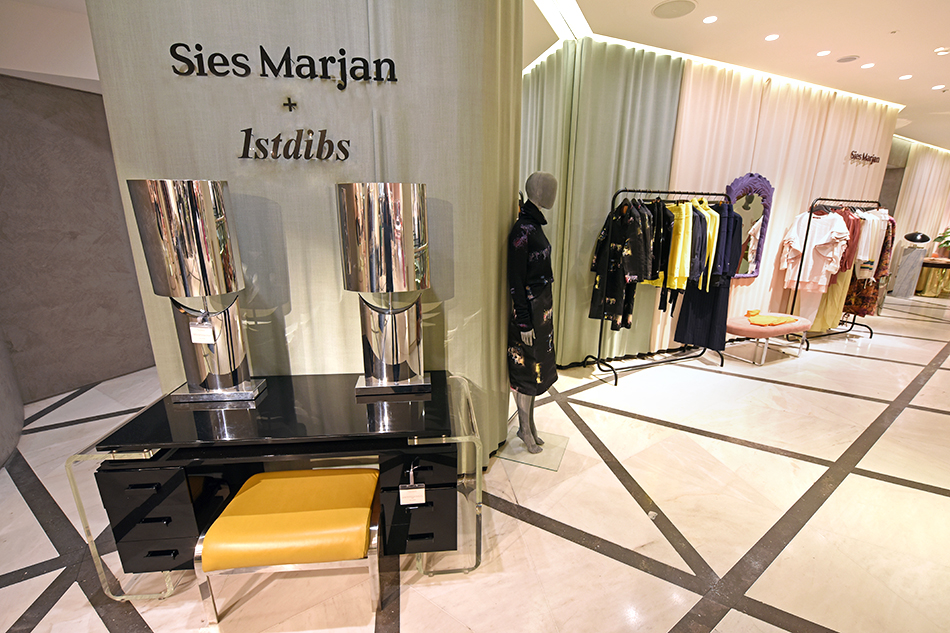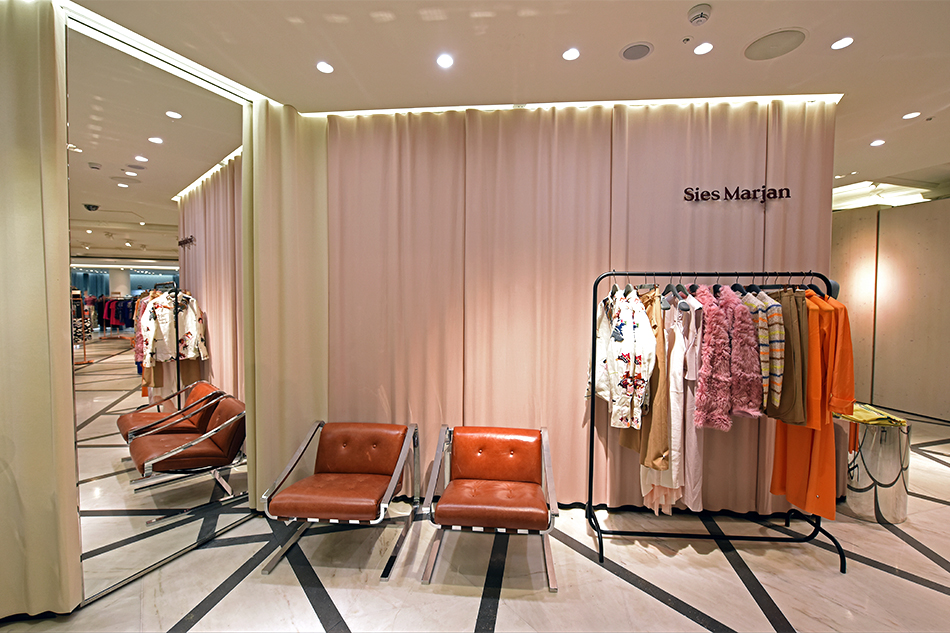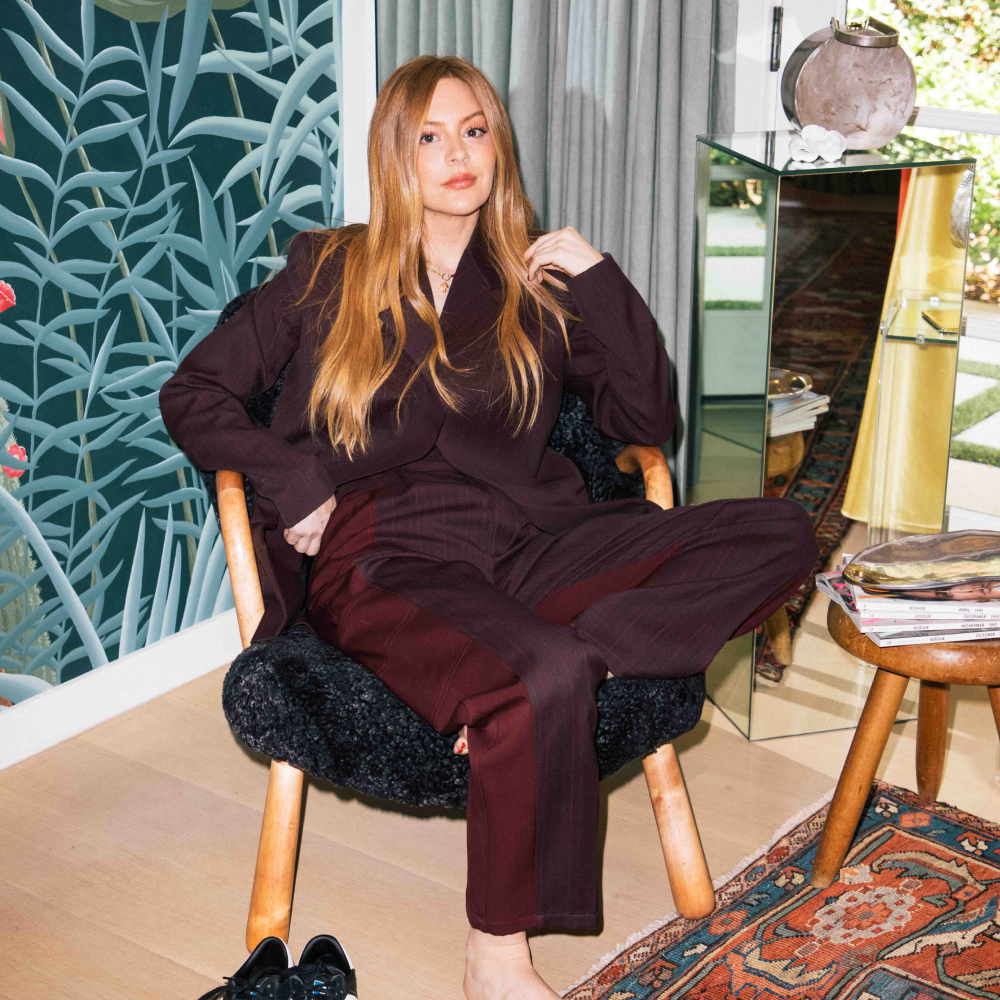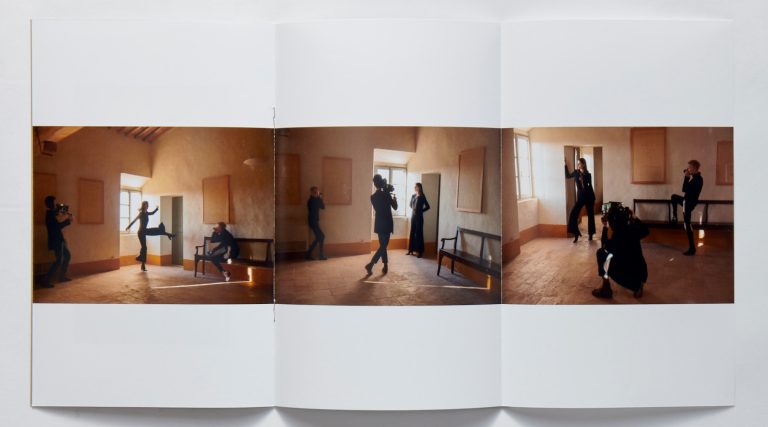
September 26, 2016A seamstress sews a tag on a sweater at the Sies Marjan atelier in Manhattan’s Chelsea neighborhood. Top: Sander Lak in his office, which contains pieces of vintage furniture. Photos by Emily Andrews
It’s three days before Sander Lak is to show his second collection for Sies Marjan, and a gaggle of reed-thin models sits in the reception area of the Chelsea atelier looking bored. The receptionist sweetly apologizes to one for not knowing where the ladies’ room is because it’s her first day, and Lak’s fashion stylist, Lotta Volkova, is stretched out on a fluffy couch in the showroom nearby, napping. Lak, however, ambles around with a relaxed smile, as if he hadn’t a care in the world.
“What we do is such a pleasure and a joy and a beautiful thing, and it should also be experienced like that,” Lak says in his spacious office, the floor of which is strewn with images and pieces of fabric, as if it were another wall. “We are doing something that is a luxury, and we should treat it that way, not like we are trying to cure some disease.”
Lak exudes a sweet cheerfulness and unpretentiousness that are rare among designers of his stratum. Dressed in a brilliant orange shirt from the Spring collection — he’s not hung up on the men’s/women’s divide — he is still riding high from his debut show, last February. “Until the day of the show, I had no idea who was going to show up. We were like, ‘Who’s going to care? Nobody knows me. Nobody knows the name or even how to pronounce it,’ ” he says. (For the record, it’s “SEES mar-JAHN,” his father’s and mother’s first names, respectively.) “We said, ‘Let’s just put it out there. It will take a few seasons before anyone of any relevance will show up.’ ”
Or so he thought. His reputation, built from stints at 3.1 Phillip Lim, Balmain (under Christophe Decarnin) and, most recently, Dries Van Noten, preceded him. “The moment I stepped out on the catwalk to do my stupid wave at the end of the show, I saw the front row and was like, ‘Holy… Holy, holy!’ ” he says. “The whole industry was there.” Specifically, Vogue editor-in-chief Anna Wintour, widely considered the most powerful person in fashion, was in attendance, as was Net-a-Porter founder Natalie Massenet.

Sies Marjan’s Spring 2017 collection, which was staged at the New York Bar Association library, displayed Lak’s confident use of color. All runway photos courtesy of Sies Marjan
Rapturous reviews followed. Fashion editors and retailers went wild for his vivid colors, please-touch textures and silhouettes featuring twisted and folded fabrics. Elle put it succinctly: “This is the collection everyone is talking about.”
Barneys New York had visited Sies Marjan early and snapped up an exclusive on the first delivery date. Following the show, an additional 28 retailers signed up for later deliveries; the company had to turn others away. For the following collection, Spring 2017, the number of retailers clamoring for the line climbed to 39. “It was crazy,” Lak says. “Now we have to live up to something that we didn’t have before. That is quite scary.”
He needn’t have worried. Within hours of the Spring 2017 show last month, Women’s Wear Daily’s Bridget Foley had hailed the collection as a “compelling combination of gentility and punch” and proclaimed, “Sander Lak has arrived.” The New York Times declared that the female members of the audience “were in a swoon.” What had them rhapsodizing were Sies Marjan’s crisscross tops, fluid pants and intricate yet somehow not overly complicated silhouettes.
The thread running through both seasons, so to speak, is Lak’s unblinking eye for color. For Spring, he went with candy hues, bright and pure as well as sun-bleached. Unlike in the Fall 2016 line, he stayed away from prints, instead pushing monochromatic head-to-toe looks. “Color is one of the things I feel very confident about,” he says. “I always felt, even as a kid, I had a real sensibility toward it. It took my parents forever to find me shoes because I was always like, ‘It’s not the right color.’ My graduation show [at Central Saint Martins] was a study of the color blue, all different shades of it.”
Lak also has a feel for texture. Among Spring’s innovations is what he calls “plastic velvet,” which has a soft, shimmery quality. Another fabric is infused with metal, which makes it crinkly but not stiff or rough. Using such technological advances, he says, is “where you can really reinvent the wheel.”

Spring 2017 pieces hang on racks in the Sies Marjan atelier.
Although he is clearly steeped in fashion history and high culture, Lak is equally enthralled with the lowbrow, from the Kardashians and Justin Bieber to QVC. He cites the color schemes of Dunkin’ Donuts, McDonald’s and Baskin Robbins as inspiration. “I love referring to things that are around me now,” he says. He uses his lunch breaks to people watch on the streets of Manhattan. “This summer I kept seeing these straight-laced guys with their khaki pants and checked shirts, in blue tones and red tones,” he says. “I’d see hundreds of them every day.”
Is he remaking that all-American look for Sies Marjan? “We’re working on it,” he says with a laugh. “I love translating real things. What we do is fantasy. But I don’t need fantasy to create fantasy. I think it’s nice to use really mundane, normal things. I sometimes see fantasy and make it really mundane. It’s more about the contradiction.”
When he’s not designing clothes, Lak is probably furnishing both his new Chelsea apartment and his design studio. He jokes that 1stdibs is “my porn.” “I’m on it every day. People check their Instagram every day — I check my 1stdibs.”
Lak traces his passion for decorating to his peripatetic childhood. He was born 33 years ago in Brunei, where his father worked as an engineer for Royal Dutch Shell. The family was transferred every four years, first to Malaysia; then to Gabon, in Central Africa; and after that to Aberdeen, Scotland. When his father died, Lak, then 10, moved with his mother and two brothers to his parents’ native Holland, where his mother married again, to a man with three children. Lak completed a bachelor’s degree there, in fashion and fashion design, before moving to London to earn his master’s in menswear at the famed Central Saint Martins.
While Lak was living with his family, the only constants in the different homes they occupied were the furniture and personal tchotchkes his mother was careful to bring along. That consistency imbued them with special meaning for Lak.

A metallic paper-bag-shaped vase adds a touch of whimsy to the studio.
“The house was always different, the culture was always different, the temperature was different, the people were different,” he says. “Everything was different except the couch and the table and the paintings. That really stuck with me, the idea of having this stuff to surround yourself with to make you feel home, wherever that is, whether the middle of the desert or the rainforest or the Scottish highlands.
“As an adult, I have the same mentality,” Lak continues. “My furniture is my home. All of my stuff comes from all of the places I have lived. There’s the table from my parents when we were in Scotland. My mom went to auctions at castles. Then I have a chair that I got in Antwerp and a table I bought in Paris when I was living there.”
In New York, where he moved in January 2015 to launch Sies Marjan, he has continued to collect furniture. “It’s almost like a diary,” he says. “Everything has a real personal connection.” Among his 1stdibs acquisitions are a mid-century Danish dining table and a burgundy leather lounge chair, also Danish, for his well-stocked library. He cannot remember the designer of either piece. Lak has strong opinions but does not hunt for specific pieces or makers. “I’m not a brand whore. I’m not a name dropper,” he says. “It just happens that I have expensive taste most of the time, but that’s something I cannot help.”
Another of his favorite hunting grounds is the street. “I do that all the time. I found a carpet the other day on the street that I reupholstered a chair with!” says Lak, who is shocked when asked if he’s worried about bugs. He also picked up a painting for $5. “I repainted it a little bit because some colors weren’t right. It’s one of my biggest paintings, and I love it. Every time people come in, they are like, ‘What is that?!’”
He’s partial to color and texture and plants — he combs 1stdibs for pots. But he tries not to eat up all the space in his apartment with furniture. “It’s already getting a bit full, so I have to stop,” he says. Luckily, he has also had to decorate the Sies Marjan studio. “This is all the stuff I couldn’t fit into my own home.”

The Sies Marjan studio is a study in contrasts. In this sitting area, for example, a sleek armchair topped with a fluffy pillow sits on a textured area rug.
Facing his desk in his studio office are twin low-slung leather chairs. “I’ve seen them around, so I think they’re quite famous chairs,” he says. “The only thing is, I expected them to be taller, and they’re quite low. If I have a really strict conversation with someone, it’s like, ‘Sit down!’ ’’ he shouts in a faux-scary voice.
The chairs were 1stdibs finds, as were several other pieces in the office. Lak also turned to 1stdibs to furnish a Sies Marjan pop-up shop at Selfridges in London this fall, open through October 15. His picks, all from the London dealer Talisman, include a veneer and brass English Art Deco double-pedestal table, circa 1940, and a pair of 1970s purple mirrors in the manner of Serge Roche.
When shopping the site, Lak takes an open-minded approach that is similar to his design process. “My generation, we click through things so much, I can go on 1stdibs and see everything in half an hour,” he says. “I tell my team, ‘Don’t just show me two fabrics. Show me hundreds, and I’ll pick the two I like. I want to see it all. I don’t have a limit to what I can digest visually. I like this idea of visual over-consumption.”
In designing, he begins with practical matters: creating the season’s “color card,” then selecting fabrics to be sure the collection will meet its deadlines. He throws shade on some designers’ tendency to wax poetic about their inspirations. “It’s not like I go to an exhibition and see, like, a Picasso sculpture, and go, ‘Oh, my God, it’s amazing! I have to make a collection,’ ” he says. “That’s so old-fashioned and boring. I really let one decision bleed into the next one.”
Lak wants the collection to stay rooted in reality. “It doesn’t need to be, ‘and a crazy color and a crazy fabric and a crazy shape and a crazy hat,’ ” he says. “I need to think it’s something I would want to see on my friends or my mom’s friends. Otherwise, I don’t understand the point.
“I’m not an artist,” he declares, expressing what many of his peers would consider blasphemy. “I don’t create art. I make clothes.”
For the moment, Lak is trying his best not to succumb to the pressure or become cocky. “Things don’t last forever,” he says. “Now, people are looking at us. There’s no guarantee that will always be the case, so let’s enjoy it for however long people care about Sies Marjan. Let’s give them everything we have, then go from there.”
